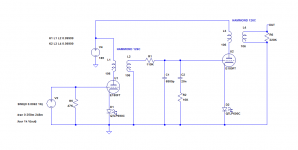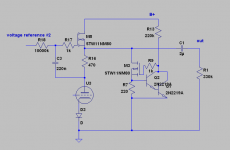I plan to build phono pre with E180F (TESLA gold pin) for Shure M 75. Hammond 126C I have in stock. I know it would be better to use Lundahl. I will use Russian Silver Mica capacitors (SGM Series). For power I plan to use 2x Salas SSHV2. I ask for comments.
Attachments
Just out of curiosity, why did you choose that tube?
Russian silver micas are the best caps for filters, absolutely.
If you're going to have SS regs (smart choise), why not have a source follower as output? Certainly it'll be best for whatever cable loads there might be. Could also double as a plate load.
Russian silver micas are the best caps for filters, absolutely.
If you're going to have SS regs (smart choise), why not have a source follower as output? Certainly it'll be best for whatever cable loads there might be. Could also double as a plate load.
Just out of curiosity, why did you choose that tube?
Russian silver micas are the best caps for filters, absolutely.
If you're going to have SS regs (smart choise), why not have a source follower as output? Certainly it'll be best for whatever cable loads there might be. Could also double as a plate load.
I like the sound of E180F in triode or in pentode mode. It also has right MU (around 50) for Phono pre. Source follower - you mean add another tube and one cap?
The 126C has a rated secondary load of 10k, but you are loading it with a much higher resistance. If you want anything remotely like a hi-fi bandwidth, you're going to have to reduce the load resistance. But since the 126C is unity gain, it doesn't actually do anything useful in this circuit, so I would suggests forgetting about it and saving the iron for another project; a resistive load would give better performance.
The E180F is also going have some fairly taxing Miller capacitance (I guess about 250pF at least), which is rather a lot to load a cartridge with. Having said that, a lot of people seem to like the sound of a load of load capacitance, so this may be a moot point to you.
The E180F is also going have some fairly taxing Miller capacitance (I guess about 250pF at least), which is rather a lot to load a cartridge with. Having said that, a lot of people seem to like the sound of a load of load capacitance, so this may be a moot point to you.
Last edited:
As Merlinb says. Instead you could use E180F in pentode mode (stage 1) and avoid miller C issues at audio frequencies, BTW. You could also obtain more gain from stage 1 that way, perhaps enough to make stage 2 a true triode cathode follower (I haven't checked), and so get back the slight partition noise stage 1 penalty? And after all, E180F is a nice little pentode, seems rude not to use it that way IMO. Not clear what the tx's add, I'd agree save them for another project. HTH !
As Merlinb says. Instead you could use E180F in pentode mode (stage 1) and avoid miller C issues at audio frequencies, BTW. You could also obtain more gain from stage 1 that way, perhaps enough to make stage 2 a true triode cathode follower (I haven't checked), and so get back the slight partition noise stage 1 penalty? And after all, E180F is a nice little pentode, seems rude not to use it that way IMO. Not clear what the tx's add, I'd agree save them for another project. HTH !
I got my inspiration here Hi-end phono preamplifier.
I also have some C3G, D3A, 6C4P, 6C3P, 6E6P. I plan to build some prototypes and compare them.
Thx for suggestions.
If you tie g2 and g3 to the plate with carbon resistors you can try out loads of pentodes without any changes d3a, 6j9 etc, some of them have opposite grid 2 and 3 pins. I have used dn2540 mu followers on my mc phonostage, you then take the aging anode impedance increase out of your filter calcs so frequently response should be more stable and at the output it works as your buffer
When talking about RIAA-stages, do you have any suggestion for how to use nuvistors type 7895/6CW4? I have built a phono preamp according to Hiraga, that sounds beautiful. But when talking to friends, someone said that nuvistors are tha sh... So very curious. Found some schematics, but want to ask, if you got experiences?
Yup, that seems to suffer similarly as to miller C effect, in principle. Thing is it sets an irreducible minimum loading C for MM carts, so you can't get below this and some cartridges might beneficially require to so. There's also phono cable C, tonearm wiring C and in this case tx self C to add in too. Whereas if stage 1 is in pentode mode, miller C at least becomes a non-issue.....Req is about 500R for a E180F in pentode mode versus about 250R for triode mode, both are OK IMO and smaller than noise source within coil resistance of typical MM cartridge anyway. And I think with good care there is enough gain available to use a single gain stage (plus buffer stage)..... and there is something 'correct' about using these excellent little pentodes in pentode mode IMO, to do things which are otherwise unavailable.I got my inspiration here Hi-end phono preamplifier.
I also have some C3G, D3A, 6C4P, 6C3P, 6E6P. I plan to build some prototypes and compare them.
Thx for suggestions.
Here's a retro Mullard amp using two EF86 pentode stages. 1st stage is a virtual earth amp, a bit different and very retro. Might offer some inspiration.........? http://vintageradio.me.uk/amplifier/preamp/preamp1.gif
talking about the 6j9p in pentode mode, I recommend you to have a look at the "best pentode" circuit by Frank Blöhbaum, in Linear audio 0. the 6J9P shows impressive noise performance in his tests!
talking about the 6j9p in pentode mode, I recommend you to have a look at the "best pentode" circuit by Frank Blöhbaum, in Linear audio 0. the 6J9P shows impressive noise performance in his tests!
Yes, and even without Frank's enhancements small signal pentodes can have similar noise performance to triodes once gain is taken into account. There's a very interesting thread, not least bondini's post #5 here http://www.diyaudio.com/forums/tubes-valves/235070-pentode-noise.html post #5 :
bondini said:This points to the usefulness of pentodes as devices with low input capacitance capable of achieving a lot of gain in a single stage, while maintaining a signal-to-noise ratio comparable to that which the triode might achieve – assuming of course that the triode could approach the pentode’s gain! This is, of course, the original rationale for designing and manufacturing small-signal pentodes.
I just think that when one has very nice little pentodes like E180Fs etc it's worth using what they are capable of, ie what they were designed for in pentode mode.
Franks's 'best pentode' fundamentally does not work, at least not as advertised. His results appear quiet because the pentode is operated effectively as a triode, cascoded with a transistor. But simply triode-strapping the pentode will still give the lowest possible noise with a given tube. Very high-gm pentodes, when triode strapped, are unbeatable for noise, but they suffer from high Miller C, microphonics, and parameter spread. So you pays your money and takes your choice. For phono use I still prefer the ECC83 /12AX7 and ECC88 / 6DJ8 as good all-round performers without such headaches.talking about the 6j9p in pentode mode, I recommend you to have a look at the "best pentode" circuit by Frank Blöhbaum, in Linear audio 0. the 6J9P shows impressive noise performance in his tests!
If you run enough juice through a triode strapped 6j9 they can rival almost any tube for distortion
6j9p 0.048% the 24ma vA210v 67vrmS

6j9p 0.048% the 24ma vA210v 67vrmS

Very true, I tried the ruggedized version with a plate like a 6c45pi but it had non of the stock valves qualitys sadly. Still they are cheap and nothing glowed.
Very true, I tried the ruggedized version with a plate like a 6c45pi but it had non of the stock valves qualitys sadly. Still they are cheap and nothing glowed.
Do you have real 6J9P Spice model?
Seeing the combination of the E180F's high gm and Merlin's note about Miller capacitance, and as you were already talking about using shunt regulators in your original post and the circuit can use them, you might also be interested in Rod C's shunt cascode with the Salas regulating the transistor's base V.
Rod explains the circuit operation here.
Rod explains the circuit operation here.
- Status
- Not open for further replies.
- Home
- Amplifiers
- Tubes / Valves
- My first phono pre

